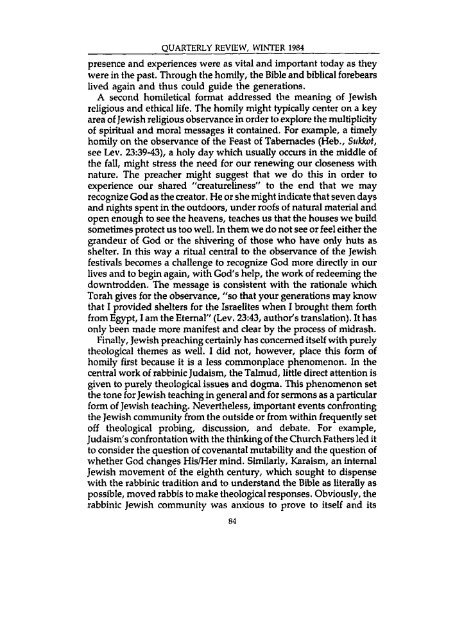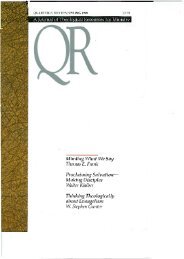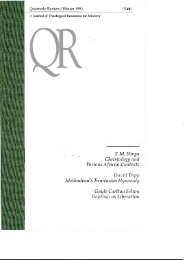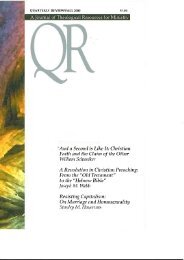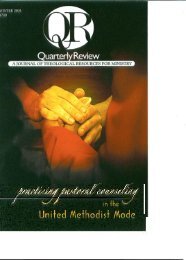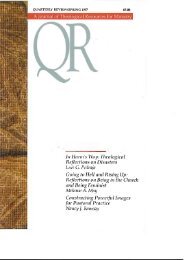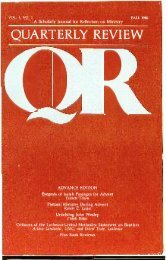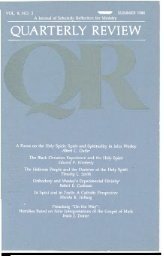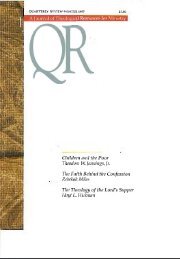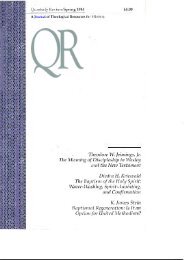Winter 1984 - 1985 - Quarterly Review
Winter 1984 - 1985 - Quarterly Review
Winter 1984 - 1985 - Quarterly Review
You also want an ePaper? Increase the reach of your titles
YUMPU automatically turns print PDFs into web optimized ePapers that Google loves.
QUARTERLY REVIEW, WINTER <strong>1984</strong><br />
presence and experiences were as vital and important today as they<br />
were in the past. Through the homily, the Bible and biblical forebears<br />
lived again and thus could guide the generations.<br />
A second homiletical format addressed the meaning of Jewish<br />
religious and ethical life. The homily might typically center on a key<br />
area of Jewish religious observance in order to explore the multiplicity<br />
of spiritual and moral messages it contained. For example, a timely<br />
homily on the observance of the Feast of Tabernacles (Heb., Sukkot,<br />
see Lev. 23:39-43), a holy day which usually occurs in the middle of<br />
the fall, might stress the need for our renewing our closeness with<br />
nature. The preacher might suggest that we do this in order to<br />
experience our shared "creatureliness" to the end that we may<br />
recognize God as the creator. He or she might indicate that seven days<br />
and nights spent in the outdoors, under roofs of natural material and<br />
open enough to see the heavens, teaches us that the houses we build<br />
sometimes protect us too well. In them we do not see or feel either the<br />
grandeur of God or the shivering of those who have only huts as<br />
shelter. In this way a ritual central to the observance of the Jewish<br />
festivals becomes a challenge to recognize God more directly in our<br />
lives and to begin again, with God's help, the work of redeeming the<br />
downtrodden. The message is consistent with the rationale which<br />
Torah gives for the observance, "so that your generations may know<br />
that I provided shelters for the Israelites when I brought them forth<br />
from Egypt, I am the Eternal" (Lev. 23:43, author's translation). It has<br />
only been made more manifest and clear by the process of midrash.<br />
Finally, Jewish preaching certainly has concerned itself with purely<br />
theological themes as well. I did not, however, place this form of<br />
homily first because it is a less commonplace phenomenon. In the<br />
central work of rabbinic Judaism, the Talmud, little direct attention is<br />
given to purely theological issues and dogma. This phenomenon set<br />
the tone for Jewish teaching in general and for sermons as a particular<br />
form of Jewish teaching. Nevertheless, important events confronting<br />
the Jewish community from the outside or from within frequently set<br />
off theological probing, discussion, and debate. For example,<br />
Judaism's confrontation with the thinking of the Church Fathers led it<br />
to consider the question of covenantal mutability and the question of<br />
whether God changes His/Her mind. Similarly, Karaism, an internal<br />
Jewish movement of the eighth century, which sought to dispense<br />
with the rabbinic tradition and to understand the Bible as literally as<br />
possible, moved rabbis to make theological responses. Obviously, the<br />
rabbinic Jewish community was anxious to prove to itself and its<br />
84


